The Comparative Bibliometric Analysis of Watershed Ecological Protection and Restoration in the Context of Territorial Spatial Planning: An Overview of Global Research Trends
Abstract
1. Introduction
2. Data Sources and Methods
2.1. Data Sources
2.2. Analysis Method
3. Conceptual Development and Theoretical Cognition of Watershed Ecological Protection and Restoration
3.1. Evolution of the Concept of Watershed Ecological Protection and Restoration in China and Abroad
3.2. Theoretical Foundations of Watershed Ecological Protection and Restoration
3.2.1. The Integral Nature of Watershed Ecological Protection and Restoration
3.2.2. Multi-Scale Characteristics of Watershed Ecological Protection and Restoration
3.2.3. Dynamic Coordination in Watershed Ecological Protection and Restoration
3.2.4. Theoretical Integration of Watershed Ecological Protection and Restoration
4. Results and Analysis
4.1. Annual Publication Volume Analysis
4.2. Analysis of Research Institutions and Authors
4.3. Keyword Network Analysis
4.4. Comparison and Trend Analysis of Hot Research Topics
4.4.1. Evolution Characteristics of English Research Articles
4.4.2. Evolution Characteristics of Chinese Research Articles
- From 2001 to 2005, China began prioritizing watershed ecological protection and restoration, predominantly at the engineering and policy stages. The primary focus areas included soil and water conservation, as well as the conversion of farmland to forest, with particular emphasis on the Yellow River and Yangtze River Basins [55,56].
- From 2005 to 2015, research expanded significantly, primarily addressing single factors that affect watershed ecology [57]. During this period, studies began to explore the influencing and driving factors of watershed ecological protection and restoration.
- The period between 2020 and 2024 has seen the most significant increase in published research. Keywords such as “Loess Plateau,” “Upper, middle, and lower reaches of the Yellow River,” and “Urban agglomerations” have emerged in the study area, thereby broadening the scope of watershed research beyond the regional scale. Concurrently, emerging research themes include the evolution of spatio-temporal patterns and driving forces [61], as well as the coupling and coordination of ecological factors [62]. In general, research on watershed ecological protection and restoration in China has experienced significant diversification over the past decade. In the past decade, research on watershed ecological protection and restoration in China has become increasingly diverse, and the influence of multiple factors across different spatial and temporal scales on ecological protection and restoration has been extensively examined [63]. This exploration has been particularly focused on research that is closely combined with relevant national policies. This trend aligns with international research developments observed after 2018.
4.5. Analysis of Research Hotspots
4.5.1. Evolution of Research Hotspots
4.5.2. Main Research Contents
- Evaluation of the Ecological Protection and Restoration of Watersheds
- 2.
- Multi-scale spatio-temporal pattern and driving mechanism of watershed ecological protection and restoration
- 3.
- Construction of a Comprehensive Management System for Watershed Ecological Protection and Restoration
5. Conclusions and Discussions
5.1. Conclusions
5.2. Discussions
- Strengthen the accurate identification and assessment of the watershed’s ecological problems with the use of big data.
- 2.
- Explore multi-scale coordinated planning and management methods for watershed ecological protection and restoration.
- 3.
- Improve the Theoretical Framework of Territorial Spatial Planning and Watershed Ecological Protection and Restoration
Author Contributions
Funding
Conflicts of Interest
Abbreviations
| CNKI | China National Knowledge Infrastructure |
| WOS | Web of Science |
| CSCD | Chinese Science Citation SM Database |
| CSSCI | Chinese Social Sciences Citation Index |
References
- Peng, J.; Xu, D.; Xu, Z.; Tang, H.; Jiang, H.; Dong, J.; Liu, Y. Ten key issues for ecological restoration of territorial space. Natl. Sci. Rev. 2024, 11, nwae176. [Google Scholar] [CrossRef] [PubMed]
- Albaladejo, J.; Díaz-Pereira, E.; de Vente, J. Eco-holistic soil conservation to support land degradation neutrality and the sustainable development goals. Catena 2021, 196, 104823. [Google Scholar] [CrossRef]
- Ziaul, I.; Wang, S. Environmental sustainability: A major component of sustainable development. Int. J. Environ. Sustain. Soc. Sci. 2023, 4, 900–907. [Google Scholar] [CrossRef]
- Shaker, R.R.; Mackay, B.R. Hidden patterns of sustainable development in Asia with underlying global change correlations. Ecol. Indic. 2021, 131, 108227. [Google Scholar] [CrossRef]
- Liu, Y.; Zhou, Y. Territory spatial planning and national governance system in China. Land Use Policy 2021, 102, 105288. [Google Scholar] [CrossRef]
- Dühr, S.; Colomb, C.; Nadin, V. European Spatial Planning and Territorial Cooperation; Routledge: London, UK, 2010. [Google Scholar]
- Zhao, H.; Wei, W.; He, M. Sustainable Implementation Strategies for Market-Oriented Ecological Restoration: Insights from Chinese Forests. Forests 2025, 16, 1083. [Google Scholar] [CrossRef]
- Lin, G.; Jiang, D.; Fu, J.; Zhao, Y. A review on the overall optimization of production–living–ecological space: Theoretical basis and conceptual framework. Land 2022, 11, 345. [Google Scholar] [CrossRef]
- Hu, G.; Huang, J.; Shi, J.; Chen, S. The formation of the Chinese territorial spatial planning system and international comparison. Trans. Plan. Urban Res. 2023, 2, 16–36. [Google Scholar] [CrossRef]
- Fu, B.; Liu, Y.; Meadows, M.E. Ecological restoration for sustainable development in China. Natl. Sci. Rev. 2023, 10, nwad033. [Google Scholar] [CrossRef]
- Zhou, L.; Huang, Y. Spatiotemporal dynamics and determinants of human-land relationships in urbanization: A Yangtze River Economic Belt case study. Front. Environ. Sci. 2024, 12, 1412047. [Google Scholar] [CrossRef]
- Zheng, Y.; Zhuang, G. Systemic governance of mountains, rivers, forests, farmlands, lakes and grasslands: Theoretical framework and approaches. Chin. J. Urban Environ. Stud. 2021, 9, 2150021. [Google Scholar] [CrossRef]
- Hou, Y.; Chen, Y.; Ding, J.; Li, Z.; Li, Y.; Sun, F. Ecological impacts of land use change in the arid Tarim River Basin of China. Remote Sens. 2022, 14, 1894. [Google Scholar] [CrossRef]
- Xu, L.; Chen, S.S. Coupling coordination degree between social-economic development and water environment: A case study of Taihu Lake basin, China. Ecol. Indic. 2023, 148, 110118. [Google Scholar] [CrossRef]
- Ding, Z.W.; Zheng, H.; Wang, J.; O’COnnor, P.; Li, C.; Chen, X.; Li, R.; Ouyang, Z. Integrating top-down and bottom-up approaches improves practicality and efficiency of large-scale ecological restoration planning: Insights from a social-ecological system. Engineering 2023, 31, 50–58. [Google Scholar] [CrossRef]
- Zhou, W.; Zhang, Y.; Yin, J.; Zhou, J.; Wu, Z. Evaluation of polluted urban river water quality: A case study of the Xunsi River watershed, China. Environ. Sci. Pollut. Res. 2022, 29, 68035–68050. [Google Scholar] [CrossRef]
- Yang, R.; Chen, S.; Ye, Y. Toward potential area identification for land consolidation and ecological restoration: An integrated framework via land use optimization. Environ. Dev. Sustain. 2024, 26, 3127–3146. [Google Scholar] [CrossRef]
- Liu, C.; Zhang, X.; Wang, T.; Chen, G.; Zhu, K.; Wang, Q.; Wang, J. Detection of vegetation coverage changes in the Yellow River Basin from 2003 to 2020. Ecol. Indic. 2022, 138, 108818. [Google Scholar] [CrossRef]
- Fu, H.; Cai, M.; Jiang, P.; Fei, D.; Liao, C. Spatial multi-objective optimization towards low-carbon transition in the Yangtze River Economic Belt of China. Landsc. Ecol. 2024, 39, 156. [Google Scholar] [CrossRef]
- Yong, X.U.; Chuansheng, W. Ecological protection and high-quality development in the Yellow River Basin: Framework, path, and countermeasure. Bull. Chin. Acad. Sci. (Chin. Version) 2020, 35, 875–883. [Google Scholar]
- Zhao, J.; Zhao, Y.; Yang, X. Evolution characteristics and driving mechanism of the territorial space pattern in the Yangtze River Economic Belt, China. Land 2022, 11, 1447. [Google Scholar] [CrossRef]
- Li, Z. Thoughts on ecological watershed planning under the territorial spatial planning. Landsc. Archit. Front. 2019, 7, 77–87. [Google Scholar]
- Palmer, M.A.; Hondula, K.L.; Koch, B.J. Ecological restoration of streams and rivers: Shifting strategies and shifting goals. Annu. Rev. Ecol. Evol. Syst. 2014, 45, 247–269. [Google Scholar] [CrossRef]
- Valentim, H.I.L.; Feio, M.J.; Almeida, S.F.P. Fluvial protected areas as a strategy to preserve riverine ecosystems—A review. Biodivers. Conserv. 2024, 33, 439–462. [Google Scholar] [CrossRef]
- Han, X.; Bian, Z.; Yu, H.; Lei, S.; Zhao, Y.; Guo, Y. The Historical and Theoretical Rationale for Ecological Protection and Restoration: Experiences from China. Land 2025, 14, 161. [Google Scholar] [CrossRef]
- Ding, X.; Zhong, Y. Knowledge mapping of platform research: A visual analysis using VOSviewer and CiteSpace. Electron. Commer. Res. 2022, 22, 787–809. [Google Scholar] [CrossRef]
- Harari, M.B.; Parola, H.R.; Hartwell, C.J.; Riegelman, A. Literature searches in systematic reviews and meta-analyses: A review, evaluation, and recommendations. J. Vocat. Behav. 2020, 118, 103377. [Google Scholar] [CrossRef]
- Rawat, K.S.; Sood, S.K. Knowledge mapping of computer applications in education using CiteSpace. Comput. Appl. Eng. Educ. 2021, 29, 1324–1339. [Google Scholar] [CrossRef]
- Poikane, S.; Kelly, M.G.; Free, G.; Carvalho, L.; Hamilton, D.P.; Katsanou, K.; Lürling, M.; Warner, S.; Spears, B.M.; Irvine, K. A global assessment of lake restoration in practice: New insights and future perspectives. Ecol. Indic. 2024, 158, 111330. [Google Scholar] [CrossRef]
- Cao, W.; Qin, W.; Wang, D. Appropriate targets for soil erosion control at the national scale determined in China. River 2023, 2, 169–172. [Google Scholar] [CrossRef]
- Luo, Y.; Lv, Y.; Fu, B.; Zhang, Q.; Li, T.; Hu, W.; Comber, A. Half century change of interactions among ecosystem services driven by ecological restoration: Quantification and policy implications at a watershed scale in the Chinese Loess Plateau. Sci. Total Environ. 2019, 651, 2546–2557. [Google Scholar] [CrossRef]
- Wang, S.; Yang, J.; Wang, A.; Yan, Y.; Liu, T. Coupled coordination of water resources–economy–ecosystem complex in the Henan section of the Yellow River basin. Water Supply 2022, 22, 8835–8848. [Google Scholar] [CrossRef]
- Gao, M.; Hu, Y.; Niu, S.; Bai, Y.; Wang, J. Identifying Priority Areas for Ecological Protection and Restoration by Constructing a Water Ecological Security Pattern. Ecosyst. Health Sustain. 2025, 11, 0310. [Google Scholar] [CrossRef]
- Bennett, A.F.; Haslem, A.; Cheal, D.C.; Clarke, M.F.; Jones, R.N.; Koehn, J.D.; Lake, P.S.; Lumsden, L.F.; Lunt, I.D.; Mackey, B.G.; et al. Ecological processes: A key element in strategies for nature conservation. Ecol. Manag. Restor. 2009, 10, 192–199. [Google Scholar] [CrossRef]
- Mackay, B.R.; Shaker, R.R. A Megacities Review: Comparing Indicator-Based Evaluations of Sustainable Development and Urban Resilience. Sustainability (2071–1050) 2024, 16, 8076. [Google Scholar] [CrossRef]
- Guo, Y.; Yang, L.; Wang, L.; Li, H.; Ge, Q. Assessment of ecological civilization construction from the perspective of environment and health in China. Eco-Environ. Health 2024, 3, 281–289. [Google Scholar] [CrossRef] [PubMed]
- Jiang, W.; Zhang, Z.; Ling, Z.; Deng, Y. Experience and future research trends of wetland protection and restoration in China. J. Geogr. Sci. 2024, 34, 229–251. [Google Scholar] [CrossRef]
- Aronson, J.; Goodwin, N.; Orlando, L.; Eisenberg, C.; Cross, A.T. A world of possibilities: Six restoration strategies to support the United Nation’s Decade on Ecosystem Restoration. Restor. Ecol. 2020, 28, 730–736. [Google Scholar] [CrossRef]
- Liu, B.W.; Wang, M.H.; Chen, T.L.; Tseng, P.C.; Sun, Y.; Chiang, A.; Chiang, P.C. Establishment and implementation of green infrastructure practice for healthy watershed management: Challenges and perspectives. Water-Energy Nexus 2020, 3, 186–197. [Google Scholar] [CrossRef]
- Ji, Q.; Liang, W.; Fu, B.; Zhang, W.; Yan, J.; Lü, Y.; Yue, C.; Jin, Z.; Lan, Z.; Li, S.; et al. Mapping land use/cover dynamics of the Yellow River Basin from 1986 to 2018 supported by Google Earth Engine. Remote Sens. 2021, 13, 1299. [Google Scholar] [CrossRef]
- Zhang, Y.; Wang, Y.; Fu, B.; Lv, Y.; Liang, X.; Yang, Y.; Ma, R.; Yan, S.; Wu, X. Identification of critical ecological areas using the ecosystem multifunctionality-stability-integrity framework: A case study in the Yellow River basin China. J. Environ. Manag. 2023, 348, 119296. [Google Scholar] [CrossRef]
- Wu, X.; Wang, S.; Fu, B.; Liu, Y.; Zhu, Y. Land use optimization based on ecosystem service assessment: A case study in the Yanhe watershed. Land Use Policy 2018, 72, 303–312. [Google Scholar] [CrossRef]
- Li, R.; Zheng, H.; Lv, S.; Liao, W.; Lu, F. Development and evaluation of a new index to assess hydrologic regulating service at sub-watershed scale. Ecol. Indic. 2018, 86, 9–17. [Google Scholar] [CrossRef]
- Trabucchi, M.; O’FArrell, P.J.; Notivol, E.; Comín, F.A. Mapping ecological processes and ecosystem services for prioritizing restoration efforts in a semi-arid Mediterranean River basin. Environ. Manag. 2014, 53, 1132–1142. [Google Scholar] [CrossRef]
- Zhang, L.; Thomas, S.; Mitsch, W.J. Design of real-time and long-term hydrologic and water quality wetland monitoring stations in South Florida, USA. Ecol. Eng. 2017, 108, 446–455. [Google Scholar] [CrossRef]
- Kammerbauer, J.; Ardon, C. Land use dynamics and landscape change pattern in a typical watershed in the hillside region of central Honduras. Agric. Ecosyst. Environ. 1999, 75, 93–100. [Google Scholar] [CrossRef]
- Shmueli, D.F. Water quality in international river basins. Political Geogr. 1999, 18, 437–476. [Google Scholar] [CrossRef]
- Azous, A.L.; Cooke, S.S. Wetland plant communities in relation to watershed development. In Wetlands and Urbanization; CRC Press: Boca Raton, FL, USA, 2000; pp. 271–280. [Google Scholar]
- Swallow, B.M.; Sang, J.K.; Nyabenge, M.; Bundotich, D.K.; Duraiappah, A.K.; Yatich, T.B. Tradeoffs, synergies and traps among ecosystem services in the Lake Victoria basin of East Africa. Environ. Sci. Policy 2009, 12, 504–519. [Google Scholar] [CrossRef]
- Mander, Ü.; Hayakawa, Y.; Kuusemets, V. Purification processes, ecological functions, planning and design of riparian buffer zones in agricultural watersheds. Ecol. Eng. 2005, 24, 421–432. [Google Scholar] [CrossRef]
- Walters, S. Modeling scale-dependent landscape pattern, dispersal, and connectivity from the perspective of the organism. Landsc. Ecol. 2007, 22, 867–881. [Google Scholar] [CrossRef]
- VanHouten, J.W. Large watershed management and restoration: Dioxin sediment remediation case study. Int. J. Environ. Stud. 2014, 71, 570–577. [Google Scholar] [CrossRef]
- Qu, S.; Wang, L.; Lin, A.; Zhu, H.; Yuan, M. What drives the vegetation restoration in Yangtze River basin, China: Climate change or anthropogenic factors? Ecol. Indic. 2018, 90, 438–450. [Google Scholar] [CrossRef]
- Wu, B.; Quan, Q.; Yang, S.; Dong, Y. A social-ecological coupling model for evaluating the human-water relationship in basins within the Budyko framework. J. Hydrol. 2023, 619, 129361. [Google Scholar] [CrossRef]
- Liao, C.; Pu, Y. Significance and countermeasures of ecological restoration project in Yangtze River Basin. People’s Yangtze River 2003, 11, 37–38+51. Available online: https://kns.cnki.net/kcms2/article/abstract?v=gHWJqxSIlt0nY9to2jDukwFcoorDdQQhDDcR30AGHkqbqBNF1sCuQTzxikiryT7ma9SyfWe8WkQYPjRAHyK5dNAI8kq2NVnAO7o6_PvFdQmINSkM0_1ql6Z5wnP7PhIcFUUsj0S-vebKyPLHJYci-U5rc7pK-TnZcoGBHhlGqTxq6kScVDzhqg==&uniplatform=NZKPT&language=CHS (accessed on 23 May 2024). (In Chinese).
- Li, G. Unified thinking to promote soil and water conservation in the Yellow River Basin. Soil Water Conserv. China 2003, 12, 9–10. Available online: https://kns.cnki.net/kcms2/article/abstract?v=7c_HF4sgkt7mv2zr5RdfJM6SpCuMFViuxg8NqSpUzo77xGVpJ85cAt_4fnkH_o4s8hAnykPNea4ZeYaWmdNhYkD5FGWp0hrLJXuyM1XxnmobuhCVAabkYP3O7wnUNnPlgeGg6FB7kdgpeWFRhf3clyMNg3mn-ICCoRAi-r1UW1pWjzu5J0J8kBw8oRAHEav&uniplatform=NZKPT&language=CHS (accessed on 23 May 2024). (In Chinese).
- Li, A.; Chen, Y. The present situation of China’s environmental protection supervision and management system and perfect countermeasures. Environ. Prot. 2013, 41, 32–34. Available online: https://kns.cnki.net/kcms2/article/abstract?v=7c_HF4sgkt7ItHdXrCERlMYLvd3IwmgFhb4ze5O_95AYn3ZTh1d2Qry5TjKEuc8npQPON9lbPI4w5ACeGkUuepBD6Sn_FJ1cJDzPqfPnKUqvfTw722uXcbSSTbK7E0KnliIuIlEaUcRNntkbNPMKZwhimCsBgyOBApQWSBXnfRxyxPe4u7FKTgu25zBwz10Q&uniplatform=NZKPT&language=CHS (accessed on 23 May 2024). (In Chinese).
- Wu, S.; An, Y.; Ma, L. Spatial and temporal differentiation of ecological service value in karst watershed under urbanization: A case study of Nanming River Basin in Guiyang City. Resour. Environ. Yangtze River Basin 2015, 24, 1591–1598. Available online: https://kns.cnki.net/kcms2/article/abstract?v=7c_HF4sgkt5Qjer5HzHjJGMrFTFDPznX-4Ku0H_aVEuNUHhqo4V9I78111iZDwdkHB3CO92ksERMvYUEbLVMF-9_T3YMz5BW4R-F-JylhPD9ifPF91sWwWfl512NgzPQUj8H-JVIzzhF7xtlRccreEPF4LZuefWYnSk8GWJzJ7ODvHu3LYrxz9zi6_Qe1Xnm&uniplatform=NZKPT&language=CHS (accessed on 23 May 2024). (In Chinese).
- Deng, W.; Deng, W.; Yuan, X.; Zhang, Y. Qi, Q. Dynamic evolution of ecosystem pattern in the Three Gorges Reservoir area. Resour. Environ. Yangtze River Basin 2015, 24, 661–668. Available online: https://kns.cnki.net/kcms2/article/abstract?v=qvsDeM7pbdkrdVarJ2euX_lQDvO-JhF4OxlW0DdV8sEF8sxgbrYrqCdW_e9pa8lEAlQTs9N1zREfJci9qj_BQHWweK6T6NnKm02idGqd-bN8bbwIqDnUnN8Huw0gFqkTomIlLGuFyPEql8vR4MLm4uOitaLUE-aKtD0A6tA7mSM64dRnnxtGkg==&uniplatform=NZKPT&language=CHS (accessed on 23 May 2024). (In Chinese).
- Li, J.; Huang, X. Optimization of Evaluation Index of ecological restoration model in Danjiang River Basin based on AHP. People’s Yangze River 2012, 34, 95–97+117. Available online: https://kns.cnki.net/kcms2/article/abstract?v=mV2q5OJ_OLwtx7zKuGYdpuCSHMZmoVbjo9jIDLKKsf4OwqghbbzgLzAjhFri4fpH3YKKf2I4MGOmKDlEAGcqOObd5FQyqjgljDovYj6yd8gIl3lxOqGzqZVTeUbBZvHNeNmaBB4K9QKA7uiisoyIIXN-Yb8QR_XupRUGiTAz7bhGujpt71nzGw==&uniplatform=NZKPT&language=CHS (accessed on 23 May 2024). (In Chinese).
- Zhang, B.; Miao, C. Spatial-temporal pattern evolution and driving forces of land use in the Yellow River Basin. Resour. Sci. 2020, 42, 460–473. (In Chinese) [Google Scholar]
- Zhao, Q. The key to ecological protection and high-quality development in the Yellow River Basin: The optimization of man-land system. J. N. China Univ. Water Resour. Electr. Power (Nat. Sci. Ed.) 2020, 41, 1–6. Available online: https://kns.cnki.net/kcms2/article/abstract?v=7c_HF4sgkt5lUfKTkcM6VxtY1xr9YPgvLKW5xGJzNIeKJMJ_161w-u5yiOYz188lYC_BllAYqJGBxLWNdYNhyx61sHcmMPso9SHT9EMRaarWhqJM-BHL-RCpi_qxB_qR2Z8z1gxGpqi-R19UrQffFJ8IcLNftG46t_nC14ZA6V1RxZpnKapHVZiV4INuT_HB&uniplatform=NZKPT&language=CHS (accessed on 23 May 2024). (In Chinese).
- Luo, M.; Yu, E.; Zhou, Y.; Ying, L.; Wang, J.; Wu, G. Distribution and technical strategies of ecological protection and restoration projects for mountains-rivers-forests-farmlands-lakes-grasslands. Acta Ecol. Sin. 2019, 39, 8692–8701. [Google Scholar]
- Shao, B.; Li, X.; Bian, G. A survey of research hotspots and frontier trends of recommendation systems from the perspective of knowledge graph. Expert Syst. Appl. 2021, 165, 113764. [Google Scholar] [CrossRef]
- Alexander, S.; Aronson, J.; Whaley, O.; Lamb, D. The relationship between ecological restoration and the ecosystem services concept. Ecol. Soc. 2016, 21. [Google Scholar] [CrossRef]
- Palmer, M.A.; Reidy Liermann, C.A.; Nilsson, C.; Flörke, M.; Alcamo, J.; Lake, P.S.; Bond, N. Climate change and the world’s river basins: Anticipating management options. Front. Ecol. Environ. 2008, 6, 81–89. [Google Scholar] [CrossRef]
- Huang, L.; Wang, J.; Chen, X. Ecological infrastructure planning of large river basin to promote nature conservation and ecosystem functions. J. Environ. Manag. 2022, 306, 114482. [Google Scholar] [CrossRef]
- Jia, Z.; Sun, T.; Lang, W.; Zhou, J.; Ding, B. Consideration on sustainable development of soil and water conservation and ecological construction in the Yellow River. Soil Water Conserv. China 2005, 12, 34–35. Available online: https://kns.cnki.net/kcms2/article/abstract?v=7c_HF4sgkt4GUaoiJEI2lMRPV7P-E1bir17j0AijU5PWOCduJlix5ItmMx2okP53EtdNNB-5Uqw1P2B6SBa_i5QDnj9xcQ1Wt8o9EJl3CZHz2iqU6n0iyc4V4-JoV2T3tHSvHBWKBswsjus9ZGdJglqgrhS4ksV9lufLykX0jwAc19fv3cbfSTNLBXzQbfMV&uniplatform=NZKPT&language=CHS (accessed on 23 May 2024). (In Chinese).
- Tan, J.; Dong, Z.; Fu, X.; Xu, W.; Liu, Q. Analysis on the evolution of landscape ecological health and its driving factors. J. Hohai Univ. (Nat. Sci.) 2015, 43, 107–113. Available online: https://kns.cnki.net/kcms2/article/abstract?v=7c_HF4sgkt6DBcfN5Yc8AD7gTrD1TVqi1dCzp5QjPXMh-OPJDHPoOI1czCnm140bWruxZ-wj8MKnESbvqiMs6pxbfkRtQokb0gFbR1CvpSoMshYBLYCPxykXYDjxC03QJLjvdZUqsDbuMu5Xqp_VJfwCcfMRK3Y8eqIXPv2ujG2ACGJYza9AgZRX9gfS69_u&uniplatform=NZKPT&language=CHS (accessed on 23 May 2024). (In Chinese).
- Fu, B. Several key points to be grasped urgently in the restoration of territorial space ecology. Bull. Chin. Acad. Sci. 2021, 36, 64. Available online: https://kns.cnki.net/kcms2/article/abstract?v=7c_HF4sgkt7ZeNa8SvyFBHHoPc862viGweg9y8nM5CmiR9kgducjmGkxdLPG2yz4fGpFWrDaBuh3zfWO_B42iAjJ1QlM3M-tLSj0oVUZm5VqzfvK4uC_0hUz96ZmRKeu5uFwObEbQRtxQ2oTyUdEsZmP3jwOnrnaB5SY3AUtyE-2pN8rcjoERpB6ZWLMZ7wq&uniplatform=NZKPT&language=CHS (accessed on 23 May 2024). (In Chinese).
- Basak, S.M.; Hossain, S.; Tusznio, J.; Grodzińska-Jurczak, M. Social benefits of river restoration from ecosystem services perspective: A systematic review. Environ. Sci. Policy 2021, 124, 90–100. [Google Scholar] [CrossRef]
- Sun, P.; Wu, Y.; Gao, J.; Yao, Y.; Zhao, F.; Lei, X.; Qiu, L. Shifts of sediment transport regime caused by ecological restoration in the Middle Yellow River Basin. Sci. Total Environ. 2020, 698, 134261. [Google Scholar] [CrossRef]
- De Groot, R.S.; Alkemade, R.; Braat, L.; Hein, L.; Willemen, L. Challenges in integrating the concept of ecosystem services and values in landscape planning, management and decision making. Ecol. Complex. 2010, 7, 260–272. [Google Scholar] [CrossRef]
- Jain, S.K.; Singh, V.P. Water Resources Systems Planning and Management; Elsevier: Amsterdam, The Netherlands, 2023. [Google Scholar]
- Li, P.; Li, D.; Sun, X.; Chu, Z.; Xia, T.; Zheng, B. Application of ecological restoration technologies for the improvement of biodiversity and ecosystem in the river. Water 2022, 14, 1402. [Google Scholar] [CrossRef]
- Zhou, J.; Zhao, Y.; Huang, P.; Zhao, X.; Feng, W.; Li, Q.; Xue, D.; Dou, J.; Shi, W.; Wei, W.; et al. Impacts of ecological restoration projects on the ecosystem carbon storage of inland river basin in arid area, China. Ecol. Indic. 2020, 118, 106803. [Google Scholar] [CrossRef]
- Peng, S.H.; Han, K.T. Assessment of aesthetic quality on soil and water conservation engineering using the scenic beauty estimation method. Water 2018, 10, 407. [Google Scholar] [CrossRef]
- Keppo, I.; Butnar, I.; Bauer, N.; Caspani, M.; Edelenbosch, O.; Emmerling, J.; Fragkos, P.; Guivarch, C.; Harmsen, M.; Lefèvre, J.; et al. Exploring the possibility space: Taking stock of the diverse capabilities and gaps in integrated assessment models. Environ. Res. Lett. 2021, 16, 053006. [Google Scholar] [CrossRef]
- Zhang, Y.; Yang, Y.; Chen, Z.; Zhang, S. Multi-criteria assessment of the resilience of ecological function areas in China with a focus on ecological restoration. Ecol. Indic. 2020, 119, 106862. [Google Scholar] [CrossRef]
- Moss, T. The governance of land use in river basins: Prospects for overcoming problems of institutional interplay with the EU Water Framework Directive. Land Use Policy 2004, 21, 85–94. [Google Scholar] [CrossRef]
- Ćwiąkała, P.; Gruszczyński, W.; Stoch, T.; Puniach, E.; Mrocheń, D.; Matwij, W.; Matwij, K.; Nędzka, M.; Sopata, P.; Wójcik, A. UAV applications for determination of land deformations caused by underground mining. Remote Sens. 2020, 12, 1733. [Google Scholar] [CrossRef]
- Li, X.Y.; Long, D.; Scanlon, B.R.; Mann, M.E.; Li, X.; Tian, F.; Sun, Z.; Wang, G. Climate change threatens terrestrial water storage over the Tibetan Plateau. Nat. Clim. Change 2022, 12, 801–807. [Google Scholar] [CrossRef]
- Nika, C.E.; Gusmarol, L.; Ghafourian, M.; Atanasova, N.; Buttiglieri, G.; Katsou, E. Nature-based solutions as enablers of circularity in water systems: A review on assessment methodologies, tools and indicators. Water Res. 2020, 183, 115988. [Google Scholar] [CrossRef]
- Shi, F.; Liu, S.; Sun, Y.; An, Y.; Zhao, S.; Liu, Y.; Li, M. Ecological network construction of the heterogeneous agro-pastoral areas in the upper Yellow River basin. Agric. Ecosyst. Environ. 2020, 302, 107069. [Google Scholar] [CrossRef]
- Ahn, S.R.; Kim, S.J. Assessment of watershed health, vulnerability and resilience for determining protection and restoration priorities. Environ. Model. Softw. 2019, 122, 103926. [Google Scholar] [CrossRef]
- Qi, Y.; Lian, X.; Wang, H.; Zhang, J.; Yang, R. Dynamic mechanism between human activities and ecosystem services: A case study of Qinghai lake watershed, China. Ecol. Indic. 2020, 117, 106528. [Google Scholar] [CrossRef]
- Sadeghi, S.H.; Hazbavi, Z.; Gholamalifard, M. Interactive impacts of climatic, hydrologic and anthropogenic activities on watershed health. Sci. Total Environ. 2019, 648, 880–893. [Google Scholar] [CrossRef] [PubMed]
- Gu, T.; Peng, J.; Jiang, H.; He, C. Watershed-based territorial ecological restoration: Theoretical cognition and key planning issues. J. Nat. Resour. 2023, 38, 2464–2474. [Google Scholar] [CrossRef]
- Lu, Y.; Chen, S. Exploring the realization pathway of carbon peak and carbon neutrality in the provinces around the Yangtze river of China. J. Clean. Prod. 2024, 466, 142904. [Google Scholar] [CrossRef]
- Sun, A.Y.; Scanlon, B.R. How can Big Data and machine learning benefit environment and water management: A survey of methods, applications, and future directions. Environ. Res. Lett. 2019, 14, 073001. [Google Scholar] [CrossRef]
- Liu, J.; Pei, X.; Zhu, W.; Jiao, J. Water-related ecosystem services interactions and their natural-human activity drivers: Implications for ecological protection and restoration. J. Environ. Manag. 2024, 352, 120101. [Google Scholar] [CrossRef]
- Lyu, F.; Tang, J.; Olhnuud, A.; Hao, F.; Gong, C. The impact of large-scale ecological restoration projects on trade-offs/synergies and clusters of ecosystem services. J. Environ. Manag. 2024, 365, 121591. [Google Scholar] [CrossRef]
- Cheng, G.; Li, X. Integrated research methods in watershed science. Sci. China Earth Sci. 2015, 58, 1159–1168. [Google Scholar] [CrossRef]
- Zhai, J.; Shen, J.; Ge, N. Cross-administrative solutions for sustainable development: The case of the Watertown Hub. Sustain. Dev. 2025, 33, 1458–1478. [Google Scholar] [CrossRef]
- Zhao, H.; Li, W. Research on the design for ecological landscape restoration of the mining wasteland. Fresenius Environ. Bull. 2021, 30, 6327–6333. [Google Scholar]
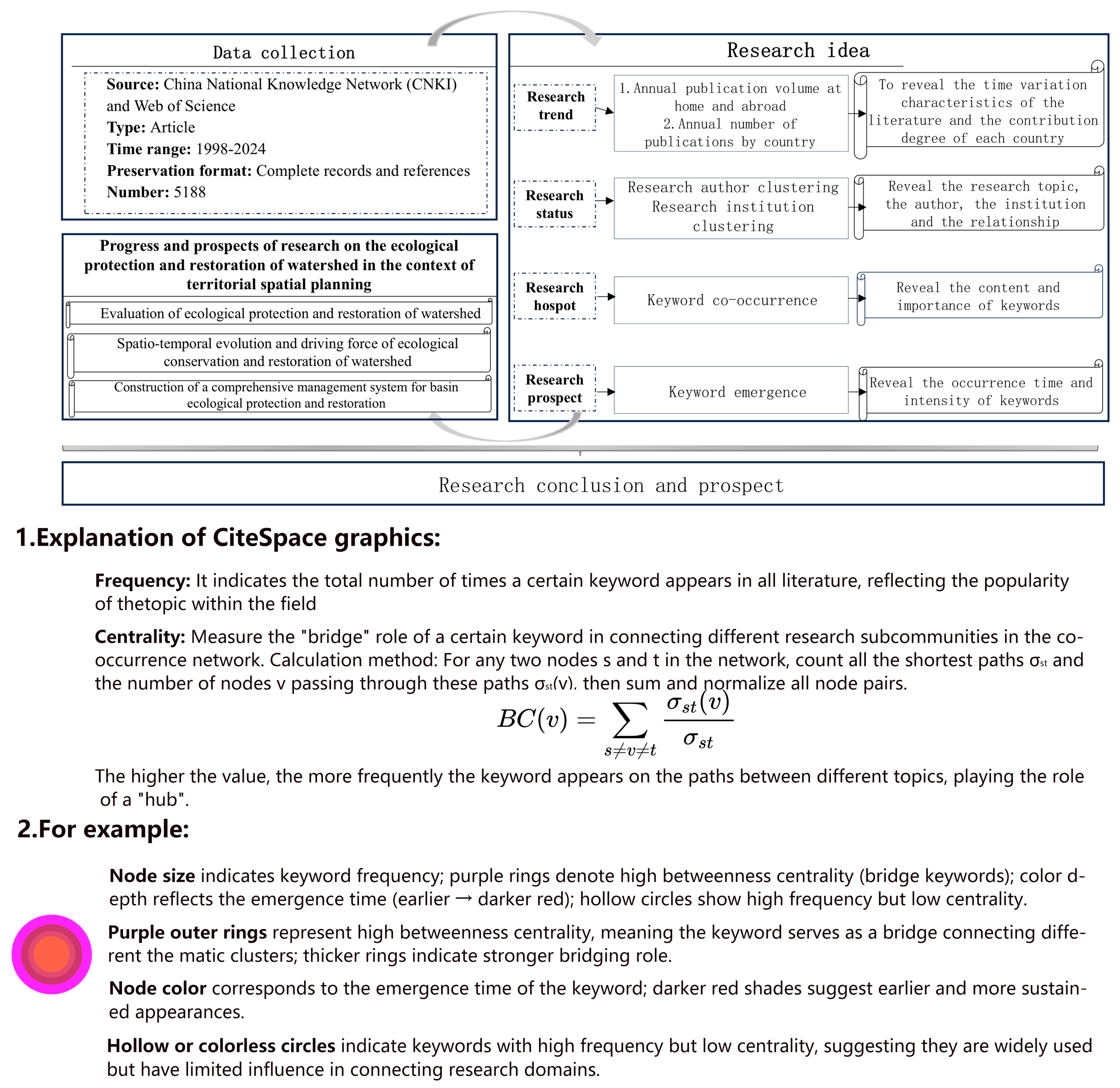

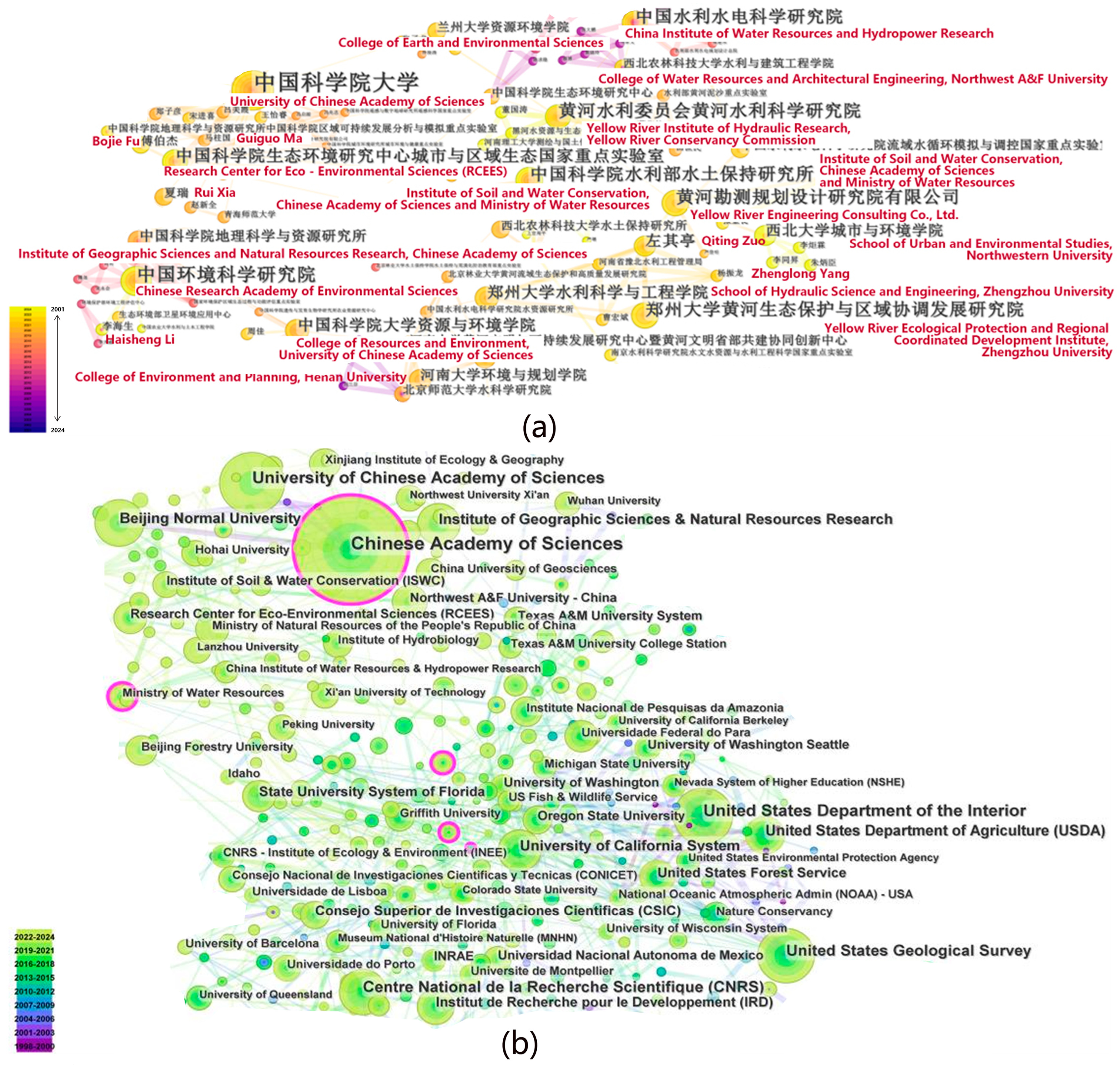
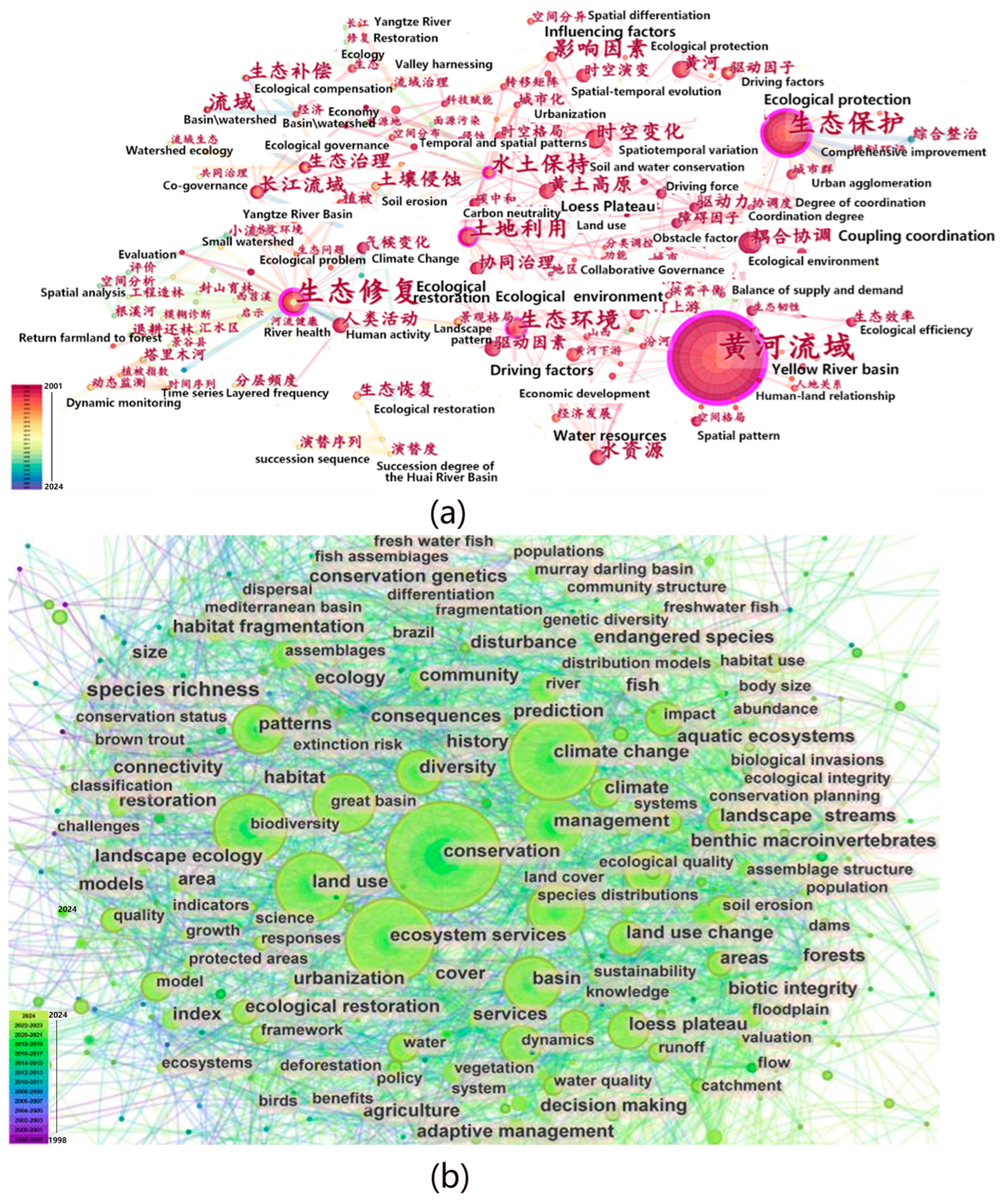
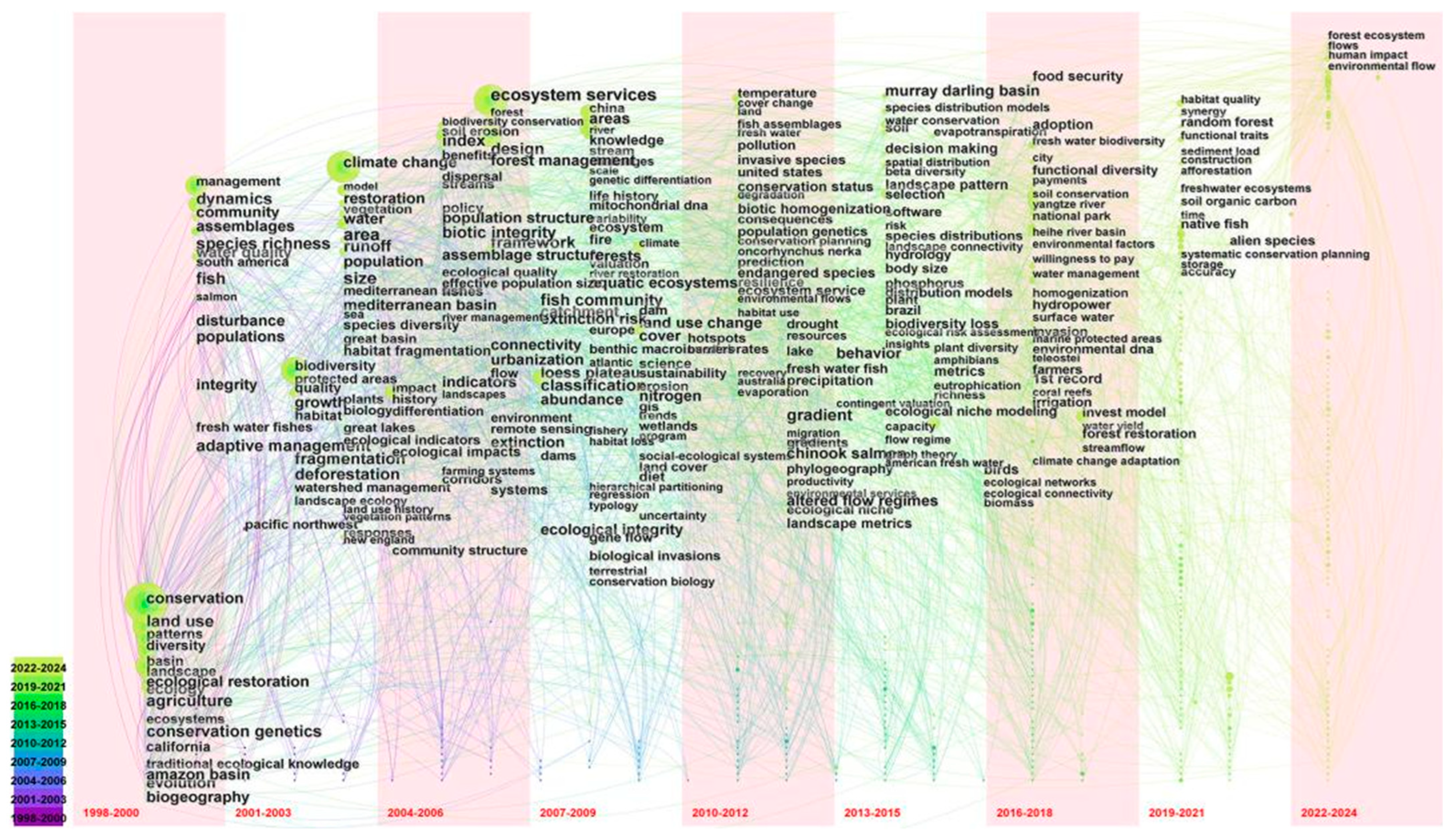

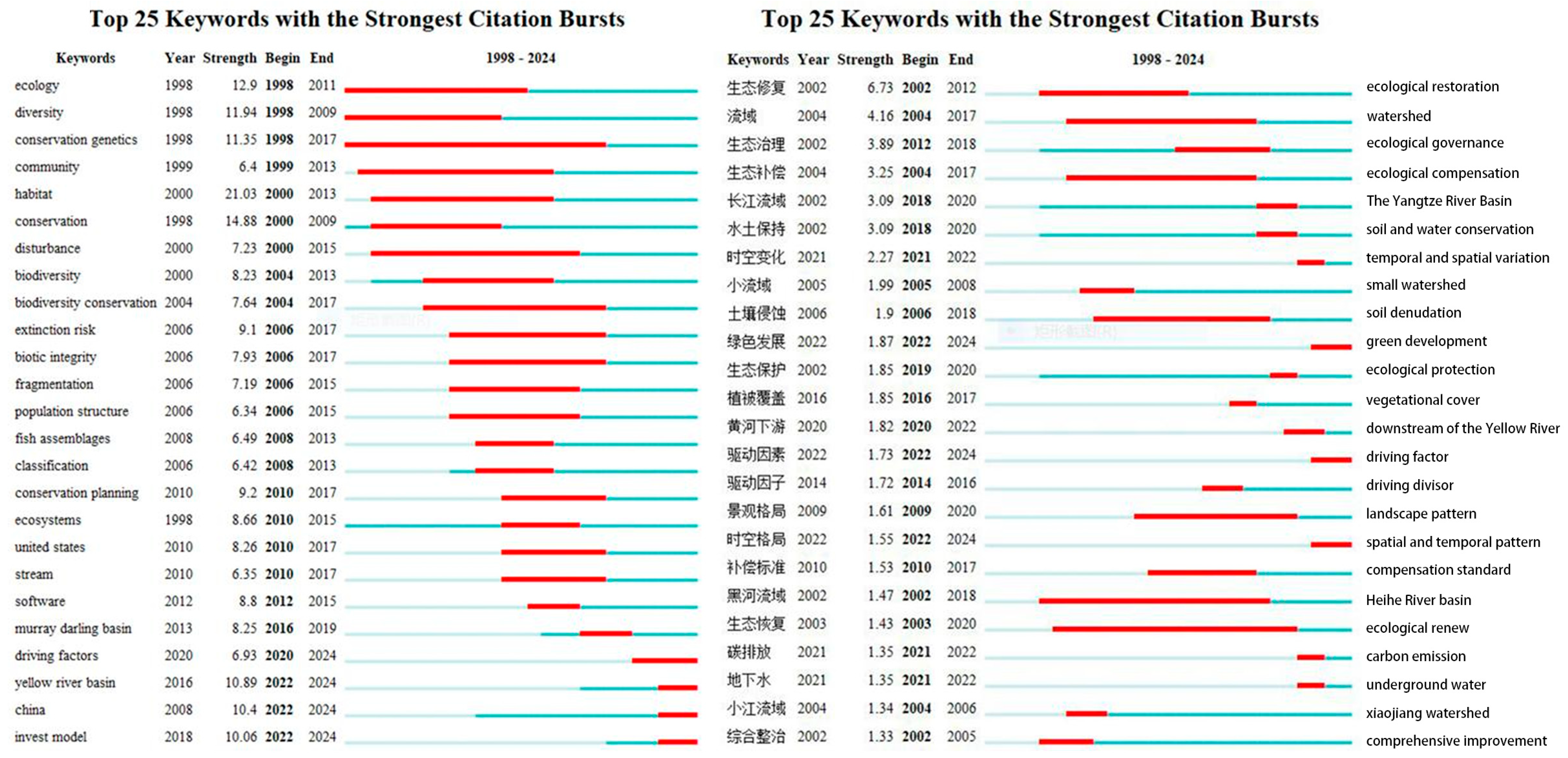
| Scale | Study Area | Ecological Protection and Restoration Objectives | Main Research Content |
|---|---|---|---|
| Macroscopic | Watershed scale (include provinces, cities) | To ascertain the factors that have led to the degradation of ecological security patterns, as well as the pivotal nodes that are crucial for the preservation and rehabilitation of the environment. | The identification of watershed ecological protection and restoration areas, the analysis of ecological security patterns or landscape pattern space-time evolution and driving mechanisms, and the construction of a comprehensive management system. |
| Middle view | Protection and restoration unit scale (include cities, counties) | Identify problems such as soil erosion and vegetation degradation and seek ways to repair them. | The evaluation of ecosystem services at the unit level, the optimization of ecological protection and restoration space. |
| Microcosmic | Sub-project scale (can include counties and towns) | Identify ecological stress problems and seek specific solutions and engineering measures | The project includes habitat restoration, returning the grain plots to forestry, the implementation of soil and water protection measures, and comprehensive land enhancement strategies. |
| CNKI Database | WOS Database | ||
|---|---|---|---|
| Organization Name | Number of Published Papers | Organization Name | Number of Published Papers |
| Chinese Academy of Sciences | 23 | Chinese Academy of Sciences | 472 |
| Chinese Academy of Environmental Sciences | 14 | University of Chinese Academy of Sciences | 192 |
| Yellow River Survey Planning Design Institute Co., Ltd. | 12 | United States Department of the Interior | 191 |
| Yellow River Conservancy Research Institute, Yellow River Conservancy Commission | 12 | United States Geological Survey | 157 |
| Yellow River Ecological Protection and Regional Coordinated Development Institute, Zhengzhou University | 12 | Centre National de la Recherche Scientifique (CNRS) | 131 |
| China Research Institute of Water Resources and Hydropower | 11 | Beijing Normal University | 124 |
| Institute of Soil and Water Conservation, Chinese Academy of Sciences | 11 | University of California | 118 |
| Research Center for Eco-Environmental Sciences (RCEES) | 10 | United States Department of Agriculture (USDA) | 110 |
| College of Resources and Environment, University of Chinese Academy of Sciences | 8 | Institute of Geographic Sciences & Natural Resources Research Institute of Geography and Natural Resources, Chinese Academy of Sciences | 108 |
| School of Economics, Lanzhou University | 8 | United States Forest Service | 80 |
| School of Hydraulic Science and Engineering, Zhengzhou University | 8 | University of Florida | 67 |
| School of Urban and Environmental Studies, Northwestern University | 7 | Research Center for Eco-Environmental Sciences (RCEES) | 62 |
| Serial Number | Chinese Subject Term | Frequency | Centrality | Serial Number | English Subject Term | Frequency | Centrality |
|---|---|---|---|---|---|---|---|
| 1 | Yellow River Basin | 325 | 0.44 | 11 | Conservation | 1186 | 0.04 |
| 2 | Ecological protection | 91 | 0.22 | 12 | Climate change | 645 | 0.03 |
| 3 | Ecological restoration | 34 | 0.38 | 13 | Biodiversity | 592 | 0.02 |
| 4 | Land use | 27 | 0.13 | 14 | Ecosystem services | 539 | 0.03 |
| 5 | Ecological environment | 24 | 0.14 | 15 | Management | 493 | 0.03 |
| 6 | Coupling coordination | 20 | 0.06 | 16 | Land use | 474 | 0.03 |
| 7 | Spatiotemporal variation | 19 | 0.05 | 17 | Patterns | 354 | 0.03 |
| 8 | Water resources | 18 | 0.08 | 18 | Diversity | 352 | 0.03 |
| 9 | Human activity | 15 | 0.06 | 19 | Community | 213 | 0.04 |
| 10 | Climate change | 11 | 0.05 | 20 | Model | 206 | 0.02 |
Disclaimer/Publisher’s Note: The statements, opinions and data contained in all publications are solely those of the individual author(s) and contributor(s) and not of MDPI and/or the editor(s). MDPI and/or the editor(s) disclaim responsibility for any injury to people or property resulting from any ideas, methods, instructions or products referred to in the content. |
© 2025 by the authors. Licensee MDPI, Basel, Switzerland. This article is an open access article distributed under the terms and conditions of the Creative Commons Attribution (CC BY) license (https://creativecommons.org/licenses/by/4.0/).
Share and Cite
Zhao, H.; Wang, G.; Wei, W. The Comparative Bibliometric Analysis of Watershed Ecological Protection and Restoration in the Context of Territorial Spatial Planning: An Overview of Global Research Trends. Land 2025, 14, 1440. https://doi.org/10.3390/land14071440
Zhao H, Wang G, Wei W. The Comparative Bibliometric Analysis of Watershed Ecological Protection and Restoration in the Context of Territorial Spatial Planning: An Overview of Global Research Trends. Land. 2025; 14(7):1440. https://doi.org/10.3390/land14071440
Chicago/Turabian StyleZhao, Hengsong, Guangyu Wang, and Wanlin Wei. 2025. "The Comparative Bibliometric Analysis of Watershed Ecological Protection and Restoration in the Context of Territorial Spatial Planning: An Overview of Global Research Trends" Land 14, no. 7: 1440. https://doi.org/10.3390/land14071440
APA StyleZhao, H., Wang, G., & Wei, W. (2025). The Comparative Bibliometric Analysis of Watershed Ecological Protection and Restoration in the Context of Territorial Spatial Planning: An Overview of Global Research Trends. Land, 14(7), 1440. https://doi.org/10.3390/land14071440









